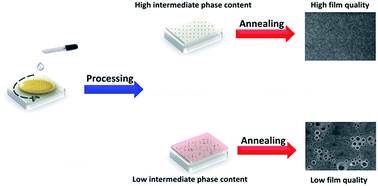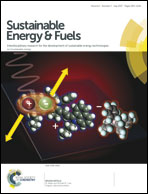Anti-solvent dependent device performance in CH3NH3PbI3 solar cells: the role of intermediate phase content in the as-prepared thin films†
Abstract
For high-performance perovskite solar cells, one-step solution deposition with anti-solvent washing is reported as an excellent processing method. In this paper, we employ attenuated total reflection Fourier transform infrared spectroscopy (ATR-FTIR), to quantitatively evaluate the relative contents of an intermediate phase in the as-prepared films, altered by anti-solvents, i.e. dichloromethane (DCM), toluene (TL), and diethyl ether (DE). Based on the joint measurements of scanning electron microscopy (SEM), X-ray diffraction (XRD), photoluminescence (PL), femtosecond transient absorption (fs-TA), current–voltage (J–V), and impedance spectroscopy, we reveal that a high content of the intermediate phase endowed with the anti-solvent DE is beneficial to film quality and device efficiency. A high coverage and pin-hole free CH3NH3PbI3 film with a long PL lifetime attained via DE washing is utilized to fabricate a CH3NH3PbI3 solar cell exhibiting over 17% power conversion efficiency. It is found that the formation of a high content intermediate phase in the as-prepared thin film is crucial to finally produce a dense and compact perovskite film with the aid of thermal annealing.



 Please wait while we load your content...
Please wait while we load your content...